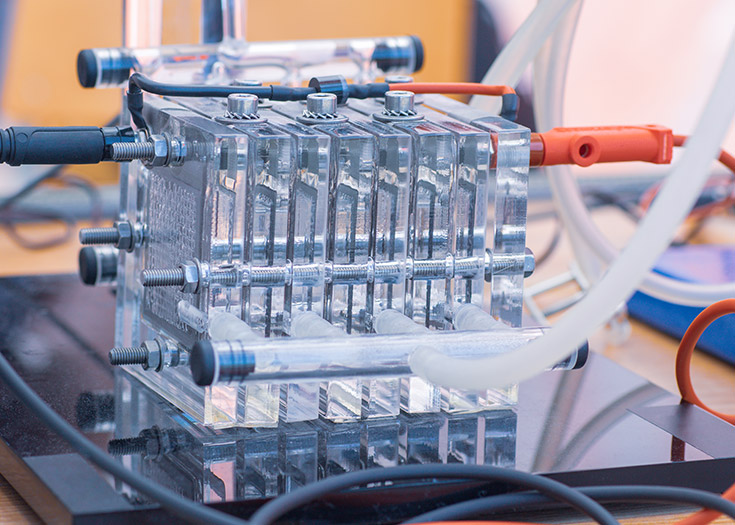
Cathode Air Filters for Fuel Cells – Information & Selection Methods
Global environmental efforts and initiatives to decrease reliance on fossil fuels promote opportunities for alternative, viable energy solutions. Hydrogen fuel cell technology, which utilizes the oxygen in filtered ambient air and stored hydrogen to create electricity, has achieved remarkable market share.
Proton Exchange Membrane (PEM) Hydrogen Fuel cells are an attractive means for power as the only byproducts are heat and water. Therefore, this fuel cell technology has zero carbon emissions and provides a very eco-friendly and sustainable option for generating power.
In the worthwhile pursuit to maximize system efficiency, each component requires analysis and optimization. PEM fuel cells consist of three major components: the anode, the cathode, and the electrolyte. Atmospheric air or “cathode air” flows through the cathode side of the fuel cell and hydrogen flows through the anode side of the fuel cell. The resulting electrochemical reaction produces an electric current that can be harnessed and used for power. Maximizing air purity for the cathode is essential for optimizing a PEM fuel cell.
Applications for Fuel Cells can generally be classified as mobile and non-mobile. Mobile applications consist mostly of larger vehicles, such as transportation buses and trucks. Non-mobile, or static applications, consist mostly of small to large-scale power production for commercial or industrial sites. The power generated can be used immediately or stored to a battery for future use. Solberg provides filtration solutions for both mobile and static applications worldwide.
Why Do Fuel Cells Need Protection and Filtration?
Prior to large scale production, most fuel cells are developed in laboratories with relatively clean and ideal air conditions. However, real world applications, especially mobile deployments, are frequently subjected to harsh environmental operating conditions which present unique challenges regarding clean air delivery and reliable performance.
There are many filtration standards, norms, and tests that are applied depending on the market segment and geographical location. Requirements for particulate and adsorptive filtration vary globally depending on the preference of the fuel cell manufacturer. Fuel cell manufacturers typically specify particulate size allowances and certain maximum concentrations of airborne constituents. Accepted norms for this market include ISO11155-1 and ISO11155-2 (previously DIN 71460.) ISO11155-1 refers to particulate size testing and ISO11155-2 addresses quantifying constituent adsorption performance.
Proper sizing of a filtration system starts by selecting the appropriate permeable medium or media. Figure 1 demonstrates the basic concept of permeable media filtration.
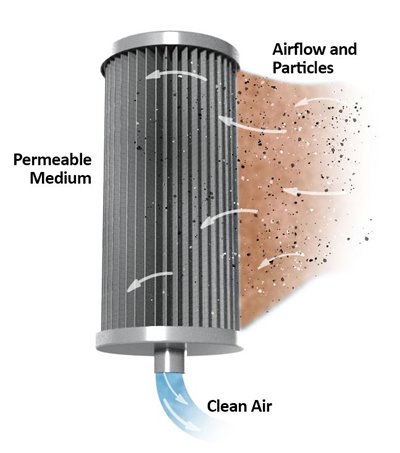
Figure 1
Filtration companies utilize different materials to achieve various filtration goals. Particulate filtration is achieved using various non-woven medias and configurations.
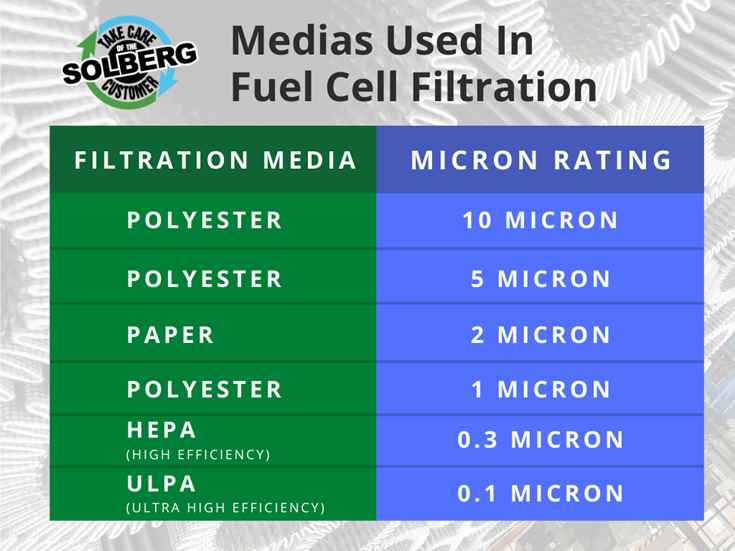
Table 1
Which Airborne Constituents Can Harm a Fuel Cell?
Adsorption of airborne constituents is a priority among some fuel cell manufacturers. This is accomplished using carbon adsorption technology. Terminology varies across different industries and around the world, however the most common referenced term is “activated carbon" technology. In general, activated carbon is integrated with filtration medias (listed above in Table 1). It can also be used alone in granular form, to achieve adsorption of unwanted constituents (shown below in table 2).
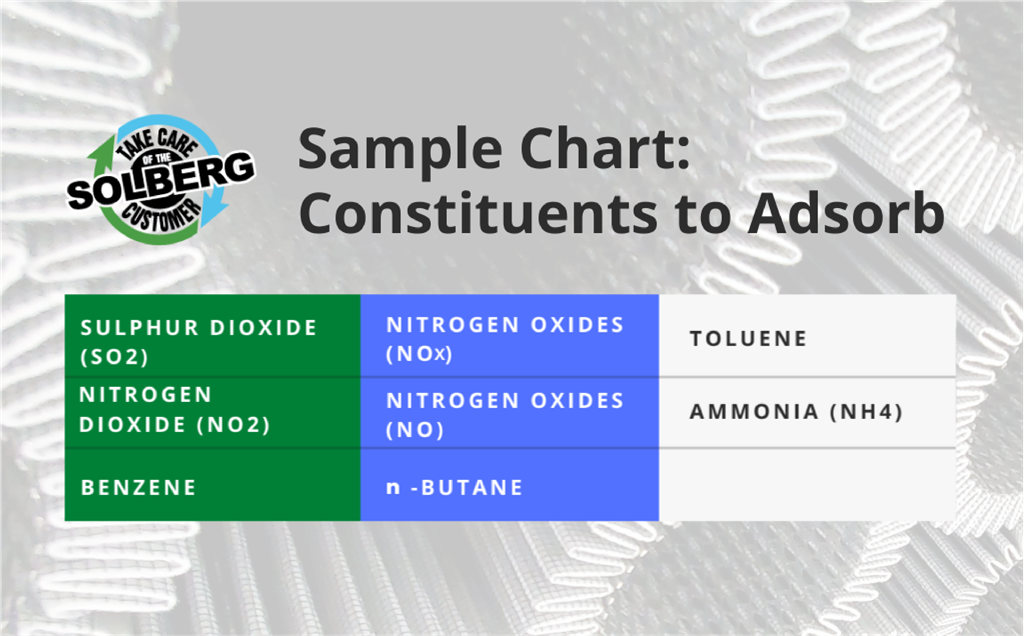
Table 2
Activated carbon filtration is commonly 3rd party tested to verify adsorption ratings in accordance with ISO norms previously mentioned or other ‘local’ standards.
Supplying Clean Air to Fuel Cells
Most fuel cells utilize a blower to pull in atmospheric air and deliver it to the cathode (see Figure 2). Many standard Intake and inline air filter designs for industrial air moving equipment are adequate for fuel cell filtration applications. Pleated filters are the industry standard because the compact design maximizes available surface area which contributes to optimal performance and prolonged element life. A typical element configuration is cylindrical with outside to inside air flow.
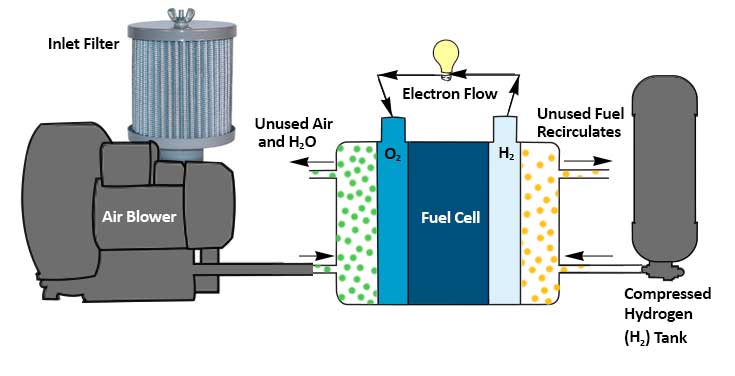
Figure 2
It is important to consider optimization of the entire system when selecting the surface area and size of a filter. From a performance perspective, a filter element will load with particulate that gradually restricts air flow over time and reduces the effectiveness of the adsorbent. The increased pressure differential across the filter element will eventually reduce air delivery and starve the cathode of required oxygen levels. Providing adequate surface area to account for anticipated dust-loading (based on the operating environment and meeting the blower’s flow curve requirements) is critical to providing the fuel cell with the clean air needed to efficiently make power. Once the media type is selected, the flow rate requirement will determine the size of the filter element needed based on required surface area.
The final stage in the design process is choosing a housing that holds the filter(s). The filter housing is designed to work with the fuel cell manufacturer’s footprint and provide the appropriate connection size and type.
Solberg manufactures the housing and filter elements as a complete solution for the fuel cell market and utilizes various proprietary pleated media combinations to achieve required particulate and adsorption filtration.
Servicing a Fuel Cell Air Filter
The filtration in these systems requires routine monitoring and servicing of filter elements. Differential pressure monitoring of the fuel cell’s performance is recommended. Differential pressure, and if applicable, adsorption capacity, will determine the filter element service intervals. In addition, humidity sensors have proven to be an acceptable way to observe a filter’s remaining adsorption capacity over time.
Conclusion
As fuel cell manufacturers seek to develop highly efficient and long-lasting fuel cell systems, specifying the right industrial air moving equipment and required filtration drives the need for collaboration with filtration specialists. Fuel cell engineers favor high efficiency rates for smaller micron particles, and adsorption filtration technologies to provide clean and contaminant-free air to the fuel cell. As a result, filtration providers must develop and supply highly efficient, compact, and economical designs.
Solberg has the expertise to supply proven and innovative filtration products for fuel cell development projects. We are well positioned to respond to market needs with our standard, configured, and custom solutions.